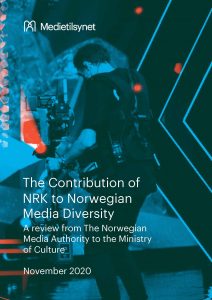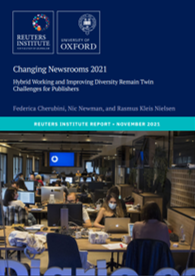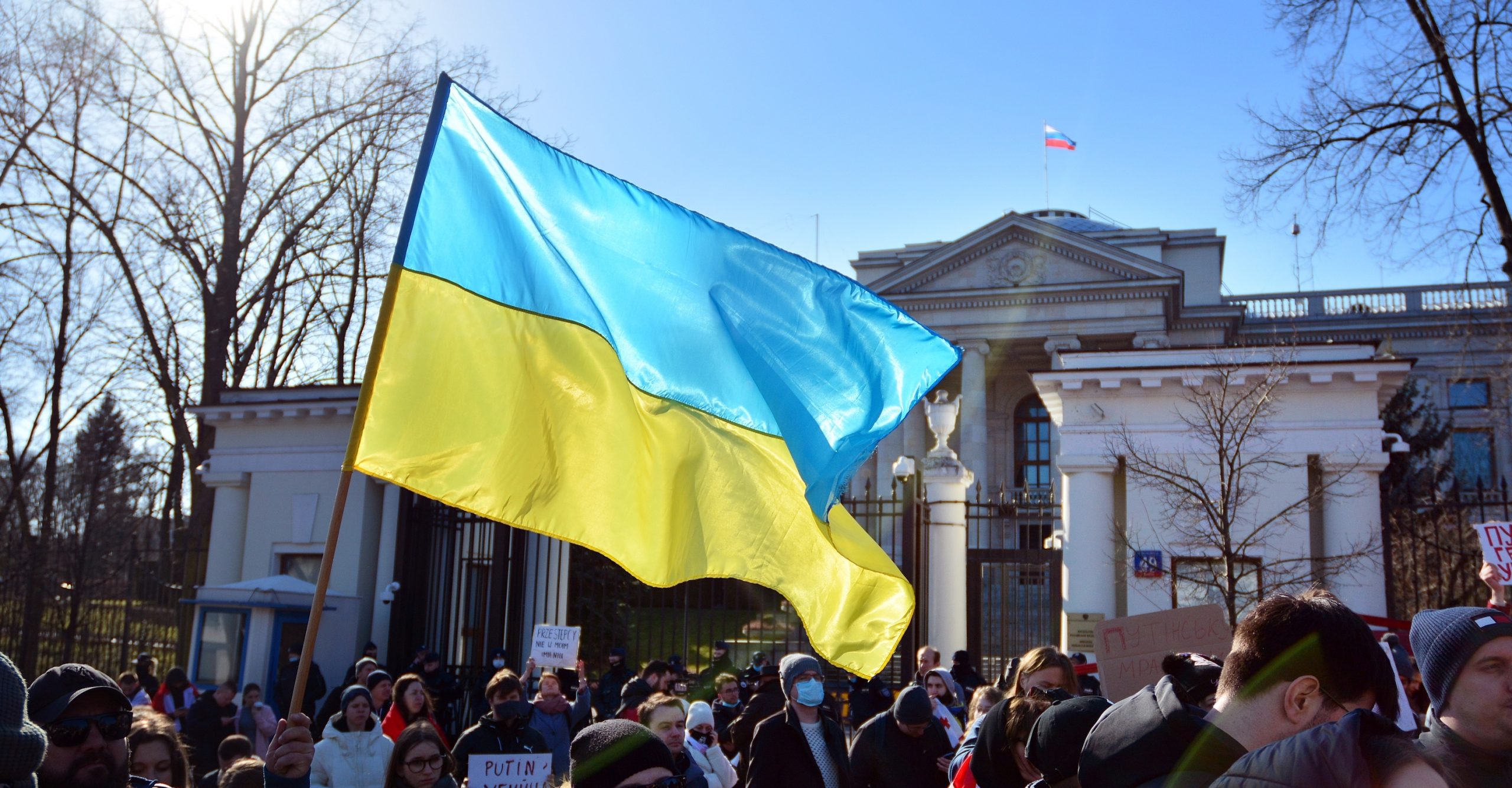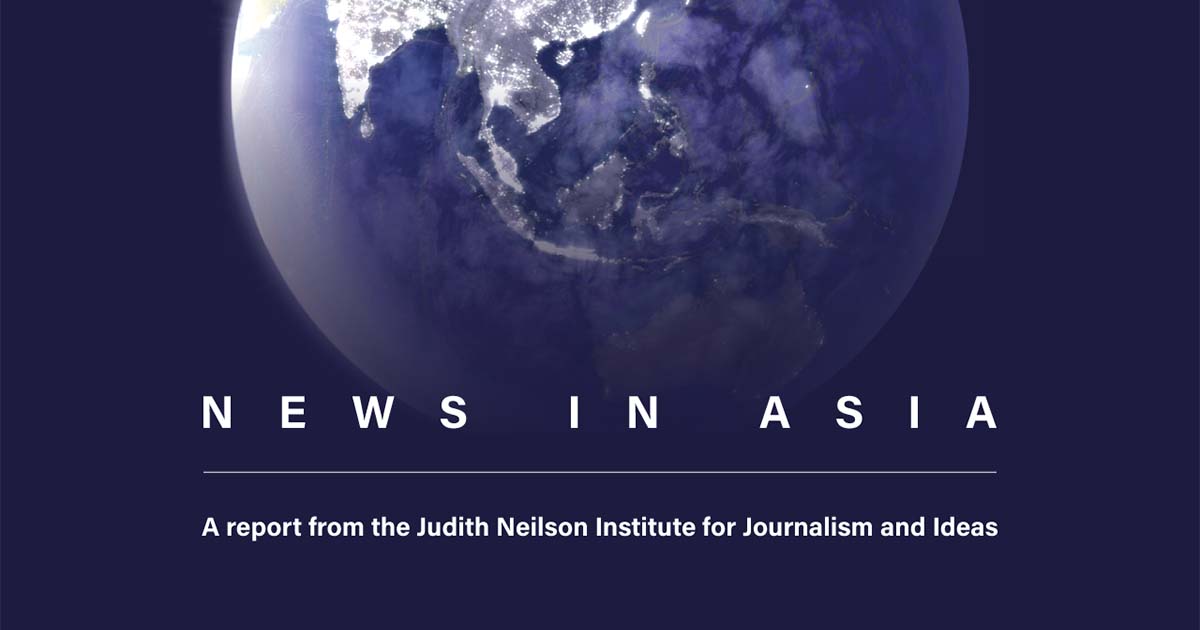Public service: A Swedish overview of knowledge (Swedish)
REPORT
Public service: A Swedish overview of knowledge
Nordicom
Published: June 2022
“The purpose of Public service: A Swedish overview of knowledge is to present in an easily accessible way what empirical research has come to in key issues concerning public service. The chapter authors are active at Swedish universities and colleges, and most of the results and conclusions presented are based on reviews of previously published research. In all chapters, the focus is on public service news journalism.
Public service: A Swedish overview of knowledge is aimed at anyone with an interest in public service – not least politicians, journalists and public debaters.”
[Text sourced from Nordicom]
Resources for Media Workers Covering the Conflict in Ukraine
WEBSITE
The Public Media Alliance team has compiled a list of recommended tools and resources for journalists and media organisations covering the fast-developing war in Ukraine. It includes links and guides on conflict reporting, financial assistance and journalist safety. This resource will be updated regularly.
Updated: 25 March 2022
Explore our other relevant tools pages, including Fact Checking & Investigative Journalism Tools and Refugee crises and migration reporting.
Featured resource
Reporters without Borders (RSF) and its local Ukrainian partner, the Institute for Mass Information (IMI) have launched a press freedom center in Lviv, Western Ukraine, that will provide vital physical and digital assistance for journalists working under dangerous conditions in Ukraine. Journalists will be offered protective equipment such as bulletproof vests and helmets; the center itself can also be used as a place for shelter in the event of an attack. They will also be offered information and advice on financial and psychological assistance.
Foreign journalists can also work from the Center between 8am and 8pm where they will have access to internet connection and live-streaming capacities.
CAN YOU HELP? RSF is calling on international donors and media outlets to contact RSF to help provide funds and equipment needed to supply the Center.
Conflict Reporting
Resources for Reporters and Editors Covering the Conflict in Ukraine
Dart Center for Journalism and Trauma – Columbia Journalism School
As Russian troops invaded Ukraine, the Dart Center has assembled a list of resources for local and international journalists who are covering this fast-developing crisis.
It includes resources on:
- Reporting and trauma-informed interviewing
- Safety
- Traumatic imagery
- Advice for managers
See also: Freelance Journalist Safety Principles
Lists, live blogs and maps
Nieman Lab
Nieman Lab has compiled a variety of lists, liveblogs and maps to follow in helping to cover the conflict, especially for those who are not too familiar with the situation.
Support and resources
International Journalists’ Network
IJNet is offering a list of reporting resources which includes tips for covering the invasion and combatting mis- and disinformation. Given the increasing numbers of people fleeing Ukraine, IJNet has also included resources for refugee reporting and mental health, alongside recommended emergency assistance, recommendations for digital and physical safety and support for independent media.
Reuters Institute’s help to cover the Russia-Ukraine crisis
Reuters Institute for the Study of Journalism
In this expanding Twitter thread, RISJ shares a curated selection of useful resources, databases and trusted news articles for journalists covering the Russia-Ukraine crisis.
See also: RISJ’s selection of articles concerning journalism’s role in covering the invasion (Twitter thread)
Tools and resources for journalists covering the Ukrainian war
Journalism.co.uk
Journalism.co.uk has a round-up of useful resources for fact-checking and trauma reporting.
The importance of ethics when reporting on conflict
Public Media Alliance
A keynote address by Dhruba Hari Adhikary on how ethics and conflict reporting interact.
Public media organisations
Public media organisations have been using their various platforms to inform the public with the latest developments on the Russia-Ukraine crisis. This non-exhaustive list highlights some of the emerging, innovative public media offerings that may inspire journalists and media workers developing their own coverage:
- 24/7 news services (Slovakia’s RTVS)
- Automatic subtitled live broadcasts (ERR)
- Extended, special current affairs programming (CBC)
- Fact-checked, educational journalism for children (SVT’s Duo app)
- Live blogs (ABC Australia)
- ‘Your Questions Answered’ (BBC’s interactive Q&A feature)
Journalist Safety
Hosting displaced Ukrainian and Russian journalists and other forms of practical support
International Press Institute
IPI is creating a database of members’ newsrooms that can provide displaced independent Ukrainian, Russian or Belarusian journalists a place to work and possibly support in finding accommodation so they can continue doing their jobs. Alternatively, they are seeking newsrooms that can offer other forms of support such as news and safety equipment.
Essential Steps for Journalists in Emergency Situations
Global Investigative Journalism Network (GIJN)
GIJN provides a list of essential documents that journalists need to hand for their evacuation plans when it comes to relocating to safer regions or countries. It specifically advises to have such documents like a passport, national ID card, various kinds of certificates (birth, marriage, professional, vaccine) as original or physical copies; photographic copies and ensure that these materials are backed up.
It also links to more of GIJN’s physical and safety advice as well as organisations that can offer additional support for relocation.
This information is also available in Arabic, Chinese, Hindi, Portuguese, Urdu, Bengali, Russian, Turkish, Ukrainian, Spanish, and Indonesian.
Pre-Assignment Preparation: Emergencies
Committee to Protect Journalists (CPJ)
CPJ has a dedicated safety portal for journalists heading into reporting on emergencies. It provides a detailed list of pre-assignment considerations and recommendations, including safety manuals and guides, planning, training, insurance, personal protective equipment (PPE), as well as medical, trauma and digital preparedness.
Safety Guide for Journalists
Reporters without Borders (RSF), UNESCO
RSF has a comprehensive handbook (published in 2015) for journalists working in high-risk environments. Developed in partnership with UNESCO, the resource covers planning and preparation; keeping safe on assignment, digital safety, best practices as well as treating physical injuries and traumatic stress. There are also sections in this guide which are relevant for covering protests/demonstrations (such as section 6 of chapter 3). There are also useful sections for managers to consider if they are sending journalists abroad to cover protests (see chapter 2, for example).
Also available in French, Spanish and Arabic.
JOURNALIST SAFETY
JOURNALIST’S TOOLBOX, Society of Professional Journalists
The SPJ has updated its JOURNALIST’S TOOLBOX page on journalist safety with a plethora of tools and videos on personal safety training, security tools worldwide, how broadcasters can set up live shots safely. Its other relevant resources mental health, pandemic reporting safety, covering protests, digital security, and public safety.
Practical and legal tools to protect the safety of journalists
Thomson Reuters Foundation
“The Thomson Reuters Foundation has partnered with UNESCO, the International Women’s Media Foundation (IWMF), and the International News Safety Institute (INSI) to develop practical and legal tools for journalists, media managers and newsrooms to counter harassment.”
Storysmart
National Union of Journalists
In December 2021, the NUJ and Google News Initiative launched an online interactive tool to ‘help journalists’ deal with hostile environments and cyber threats.’ It takes the form of 10-20 minute online interactive modules that delve into risk in hostile environments, psychological trauma, cybersecurity and dealing with injury, including advice from hostile environment trainers, cyber-security experts and experienced journalists.
SaferJourno – Digital Security Resources for Media Trainers
Internews
“SaferJourno is a free and open-source curriculum guide for media trainers who teach students, professionals and peers digital safety and online security. SaferJourno provides lesson plans for six different modules; assessing risks, basic protection, mobile phone safety, keeping data safe, researching securely, and protecting email. The toolkit starts with the trainer’s guide, which walks journalism and media trainers through easy-to-use adult teaching and learning approaches.” [Text sourced from SaferJourno]
The toolkit is also available in Spanish.
Safety package
International Media Support
IMS’ safety package includes training in risk analysis, first aid, conflict sensitive journalism, media laws and code of conducts, as well as practical measures such as a 24/7 hotline, safe houses, safety equipment, legal and emergency assistance. Its advocacy work includes monitoring attacks and threat levels as well as engaging with governments on the protection of journalists. All of IMS’ safety work is in conjunction with the UN Plan of Action on the Safety of Journalists and Issue of Impunity.
9 ways journalists can push back against the stress of an always-on story
Poynter
Mental health tips and resources for journalists
International Journalists’ Network (IJNET)
Tips and resources for journalists to safeguard not only their own mental health but also the mental health of their sources. This resource also includes a webinar on journalists’ mental health, hosted by International Journalists’ Network (IJNET) and which featured panellists Bruce Shapiro, executive director of the Dart Center for Journalism and Trauma at Columbia University; and Sherry Ricchiardi, Ph.D., co-author of ICFJ’s Disaster and Crisis Coverage guide and international media trainer.
Financial Assistance
Many media and journalist groups offer financial support, which can help to assist media workers with temporary and urgent support, including relocation, legal or medical assistance.
EFJ and IFJ Ukraine Safety Fund
European Federation of Journalists, International Federation of Journalists
EFJ and IFJ have set up a joint, dedicated fund for journalists. “All funds donated will be used directly to provide emergency assistance to support journalists under threat.” They include supplying journalists with first aid kits, flak jackets, helmets and medical supplies, as well as assistance with relocation and humanitarian assistance.
Donations can be made here.
IPI Ukraine Solidarity Fund: Financial and humanitarian support
International Press Institute
“All funds raised will go directly to independent media in Ukraine. IPI is working closely with several trusted partners to distribute funding to a range of journalists in the country, including The Fix and the Media Development Foundation, which has coordinated emergency funding to nearly 60 independent media organizations in Ukraine. Through the IPI Ukraine Solidarity Fund we will be able to provide a united contribution from IPI members to media with urgent needs.” IPI members can donate here.
IFJ Safety Fund
International Federation of Journalists
“Offers financial assistance in a range of emergency cases such as threats, violence and threats thereof, prosecution, settlement in exile and illness.”
Media Lifeline Ukraine
Free Press Unlimited
The Media Lifeline is FPU’s contribution to maintain independent reporting in Ukraine. It is a coalition that aims “to protect journalists and keep reliable information available in and around Ukraine which we believe will be absolutely essential for the longer term”.
Emergency Fund Intake Form
International Women’s Media Foundation
IWMF provides women journalists with a lifeline of support in times of distress or threat. It offers women journalists small grants for physiological and medical care for incidents directly related to their work; three months of temporary relocation assistance; legal aid, as well as non-financial assistance including information and additional access to resources.
Protective Kit for Freelance Journalists
Rory Peck Trust
The Rory Peck Trust is raising funds to protect as many journalists working on the ground in Ukraine to cover the war, by supplying them with official protective safety kit, including a flak jacket and helmet. These will be procured and delivered by their partners Journalists in Distress.
See also: the Rory Peck Trust Crisis Fund which supports freelance journalists in need of help with temporary relocation or accommodation.
Global Forum for Media Development crisis/emergency list
Global Forum for Media Development
The GMFD has curated an extensive list of organisations providing emergency funding during the Russia-Ukraine conflict. Available in English and Ukrainian.
See also: a page of information on fundraising and crowdfunding for media and journalists in Ukraine.
Eastern European Independent Journalist Fund
Transitions
Prague-based journalism training organisation Transitions has set up the Eastern European Independent Journalist Fund in partnership with the South East European Network for Professionalization of Media (SEENPM) and various other media support centers to provide an “urgent lifeline for journalists from Ukraine, Russia, and Belarus”. The Fund will pay freelance journalists and those working for independent local or national media especially as their normal incomes decrease as a result of the war.
Fundraiser for Ukrainian independent media
The Kyiv Independent
A GoFundMe page has been set up by a senior executive of The Kyiv Independent to support Ukraine’s independent media
Header Image: Warsaw, Poland. 24 February 2022. Anti-war protest outside Russian embassy in Warsaw. Demonstrators call for peace and condemn Putin. Credit: Grand Warszawski / Shutterstock.com
Funding Democracy: Public Media and Democratic Health in 33 Countries
REPORT
Funding Democracy: Public Media and Democratic Health in 33 Countries
The International Journal of Press/Politics | Timothy Neff and Victor Pickard
Published: 2021
Neff and Pickard’s new report provides further evidence that where public media is better funded, with secure funding and regulatory frameworks, they are “consistently and positively correlated with healthy democracies”, and that citizens are more likely to engage in democratic processes. The study is based on a framework by Hallin and Mancini of North American and European media systems, and in correlation with the rankings of the 33 countries in the top two tiers of The 2019 Democracy Index (“full” and “flawed” democracies), developed by The Economist’s Intelligence Unit (EIU).
The Contribution of NRK to Norwegian Media Diversity
REPORT
The Contribution of NRK to Norwegian Media Diversity
A review from The Norwegian Media Authority to the Ministry of Culture
Medietilsynet
Published: November 2021

“In a report published on 29 November 2021, the Norwegian Media Authority (NMA) concludes that the public service media provider NRK contributes positively to media diversity and to the overall offer to the public by fulfilling its public service broadcasting remit and by working with other actors in the Norwegian media market. A detailed summary of the report is now available in English.
The objective of the report, commissioned by the Ministry of Culture, was to identify how NRK contributes to diversity of content and exposure, whether it fulfils its duty to cover thematic and geographic blind spots and how the competitive effects of its activities impact on the media market. on online news and current affairs.
The review is based on the analysis of quantitative and qualitative data and studies from a wide range of sources including NRK, public authorities, consultants and academic researchers and takes into consideration input from the media industry.”
[Text sourced from the European platform of regulatory authorities]
Changing Newsrooms 2021
REPORT
Changing Newsrooms 2021
Hybrid Working and Improving Diversity Remain Twin Challenges for Publishers
Reuters Institute for the Study of Journalism, Oxford University | Federica Cherubini, Nic Newman, and Rasmus Kleis Nielsen
Published: 2021

The return to the office is underway but with COVID-19 lingering in a number of countries, progress remains uneven and uncertain. Many will find newsrooms very different places to the ones they left. For some, the office has disappeared completely.
This report, which is based on a survey of 132 senior industry leaders from 42 countries as well as a series of in-depth interviews, makes clear that ‘hybrid working’ will soon be the norm for the vast majority of journalists in many news organisations – with some people in the office and others working remotely – and that the industry is still struggling with attracting talent and addressing lack of diversity.
[Text sourced from the RISJ]
A Framework for Assessing the Role of Public Service Media Organizations in Countering Disinformation
JOURNAL
A Framework for Assessing the Role of Public Service Media Organizations in Countering Disinformation
University of Helsinki, Finland; Cardiff University, UK; Central European University, Austria; Complutense University of Madrid, Spain | Minna Horowitz , Stephen Cushion , Marius Dragomir, Sergio Gutiérrez Manjón, and Mervi Panti
Published: 2021
Public service media (PSM) are widely acknowledged as part of the variety of solutions to disinformation. The remit of PSM, formed around values of universality, equality, diversity, accuracy and quality, implies a responsibility to fight disinformation by producing fact-based news content and finding anti-disinformation solutions. In this article, we introduce a framework for assessing how PSM organizations are able to counter disinformation in different contexts. Our normative framework provides a triangulation of contextual factors that determine the role of the PSM organization in the national environment, the activities carried out to fight disinformation and expert assessments of the potential of PSM to reduce the impact of disinformation. The framework is illustrated with analyses of PSM from the Czech Republic (CZE), Finland, Spain and the United Kingdom (UK).
[Text sourced from the Taylor and France Online]
British Public Service Broadcasting, the EU and Brexit
REPORT
British Public Service Broadcasting, the EU and Brexit
Department of Journalism, Media and Culture, Cardiff University, Cardiff, UK | Mike Berry, Karin Wahl-Jorgensen, Inaki Garcia-Blanco, Lucy Bennett and Joe Cable
Published: 2021
This paper analyses the historic role of Britain’s major public service broadcaster, the BBC, in reporting the European Union. To do this it combines a content analysis of two datasets of BBC broadcast and online coverage from 2007 and 2012 with a series of semi-structured interviews conducted with former and current senior BBC editors and journalists. The research finds that BBC coverage in the pre-referendum period was closely tied to major events – such as summits – and elite party conflict. These patterns in coverage were primarily a consequence of the lack of traditional news values inherent in most EU stories and the impact of the wider political and media landscape. The consequence of these patterns in coverage was to present audiences with a restricted, negative and largely conflictual picture of Britain’s relationship with the EU which is likely to have fuelled rather than inhibited the growth of Euroscepticism.
[Text sourced from the Taylor and France Online]
Mutual Aid and the “Messy Middle”: pushing public radio toward antiracism
REPORT
Mutual Aid and the “Messy Middle”
Pushing public radio toward antiracism
The Tow Center for Digital Journalism at Columbia’s Graduate School of Journalism | Andrea Wenzel
Published: 2021
Across the U.S., a number of public media stations have been undertaking initiatives with the aim of making their newsrooms and their journalism more inclusive of Black, Indigenous, and people of color and other marginalized communities. These initiatives have taken a variety of forms, including tracking the diversity of their sources; diversity, equity, and inclusion (DEI) workshops and trainings; and community engagement initiatives.
[Text sourced from the Tow Center]
News in Asia
REPORT
News in Asia
Understanding news media in the world’s most important region
The Judith Neilson Institute for Journalism and Ideas | Various authors
Published: 2021
In September 2021, the Judith Neilson Institute, an organisation based in Sydney but works with journalists and media organisations around the world, published its report, bringing together experts and institutions to provide a nuanced account of journalism in Asia. The report covers a comprehensively covers a broad range of topics, from changing news production and consumption to the impact of COVID-19 on the news media landscape and media development.
The Public Media Alliance is proud to have also contributed to such an important and timely project. In our chapter we explore the changing role of national broadcasters in Asia with a slide towards greater state control, and how public media is being redefined and normalised as a form of national broadcasting with less editorial independence – a key principle of public media. Read our chapter.
The State of State Media
REPORT
The State of State Media
A Global Analysis of the Editorial Independence of State Media and an Introduction of a New State Media Typology
Center for Media, Data and Society, CEU Democracy Institute | Marius Dragomir and Astrid Söderström
Published: 2021
CMDS Director Marius Dragomir introduces a new tool to assess the editorial independence of the world’s state media and finds that nearly 80% of 546 state-administered media companies in 151 countries lack editorial independence.
[Text sourced from CMDS]

